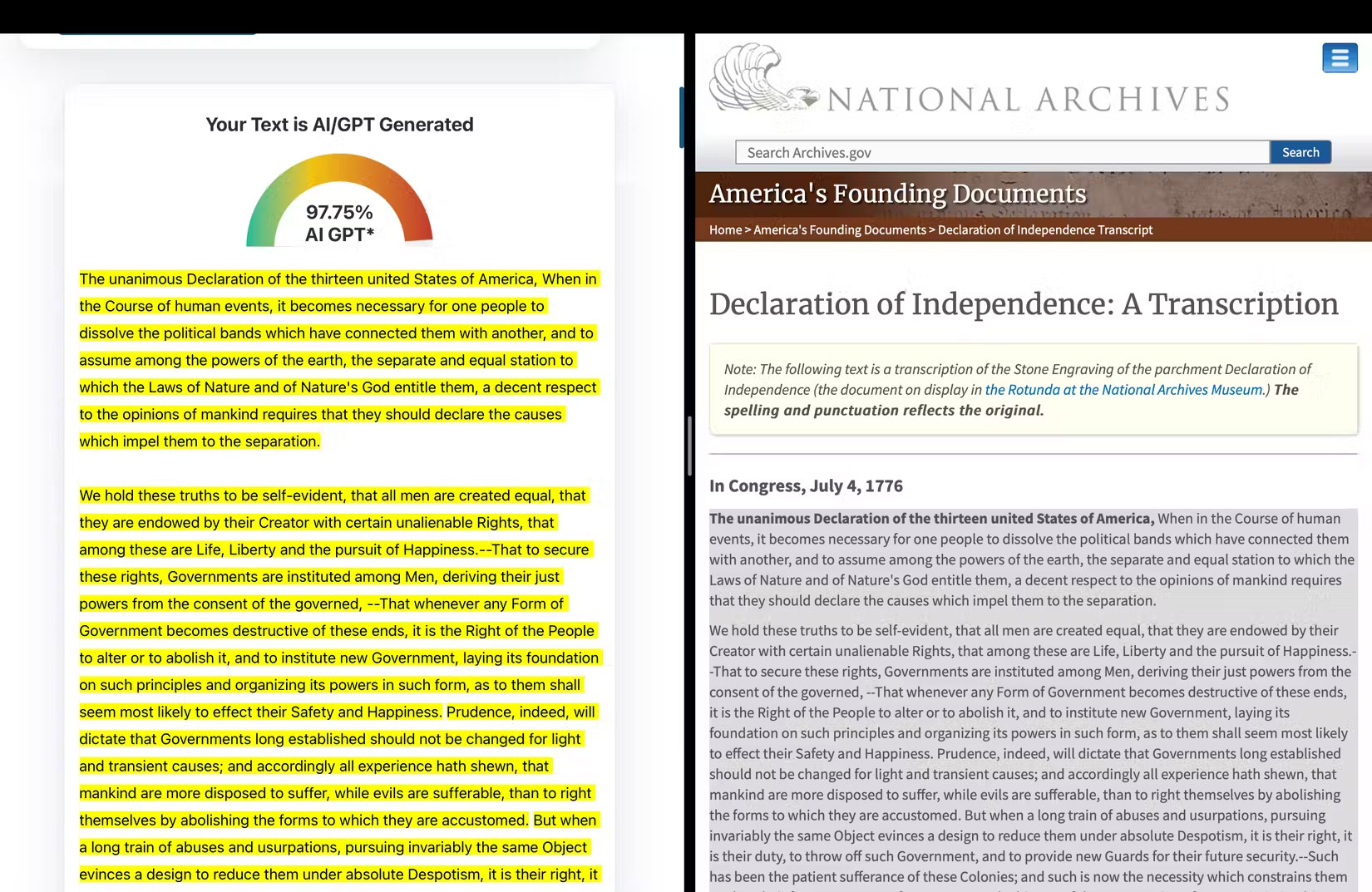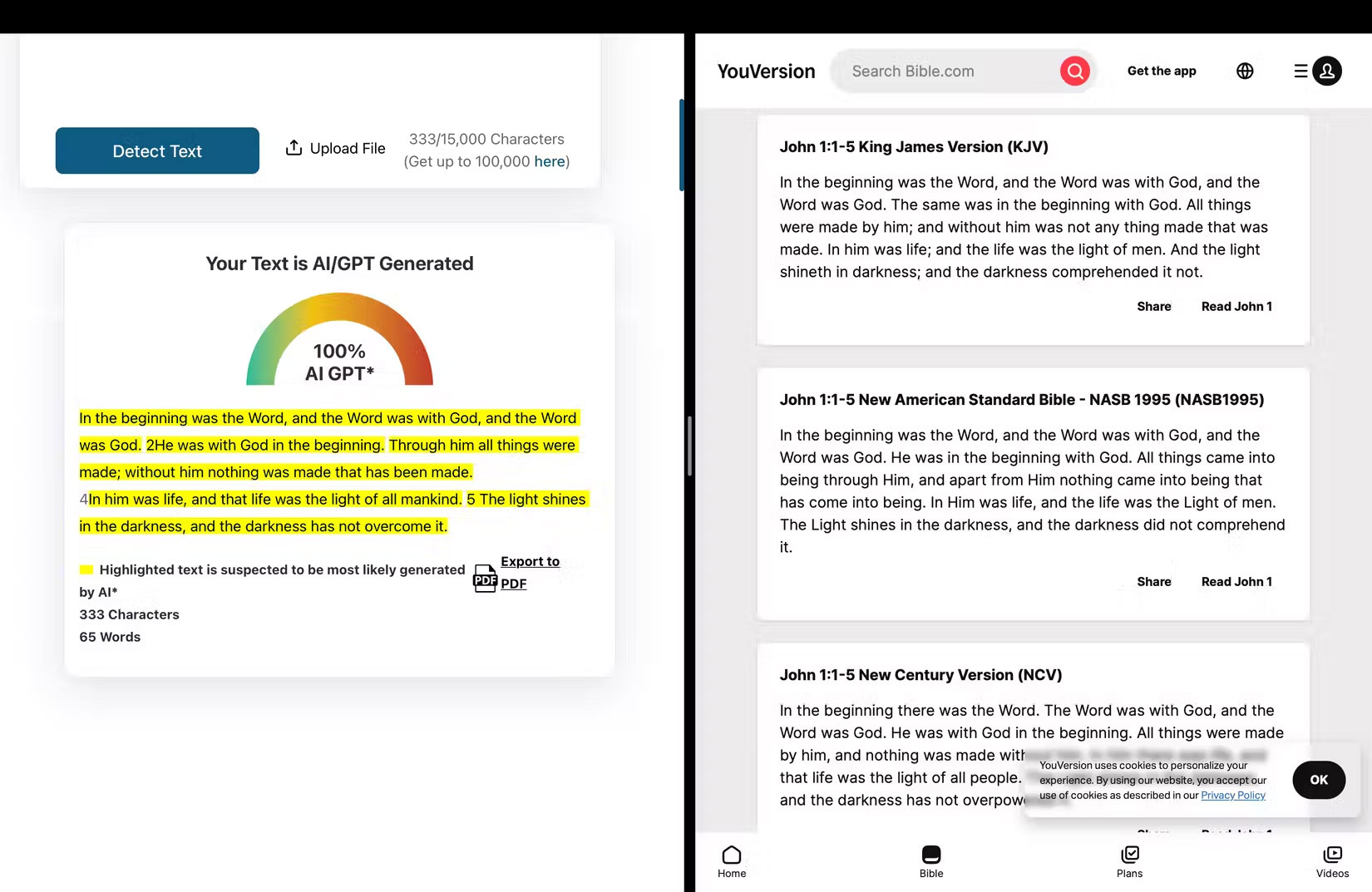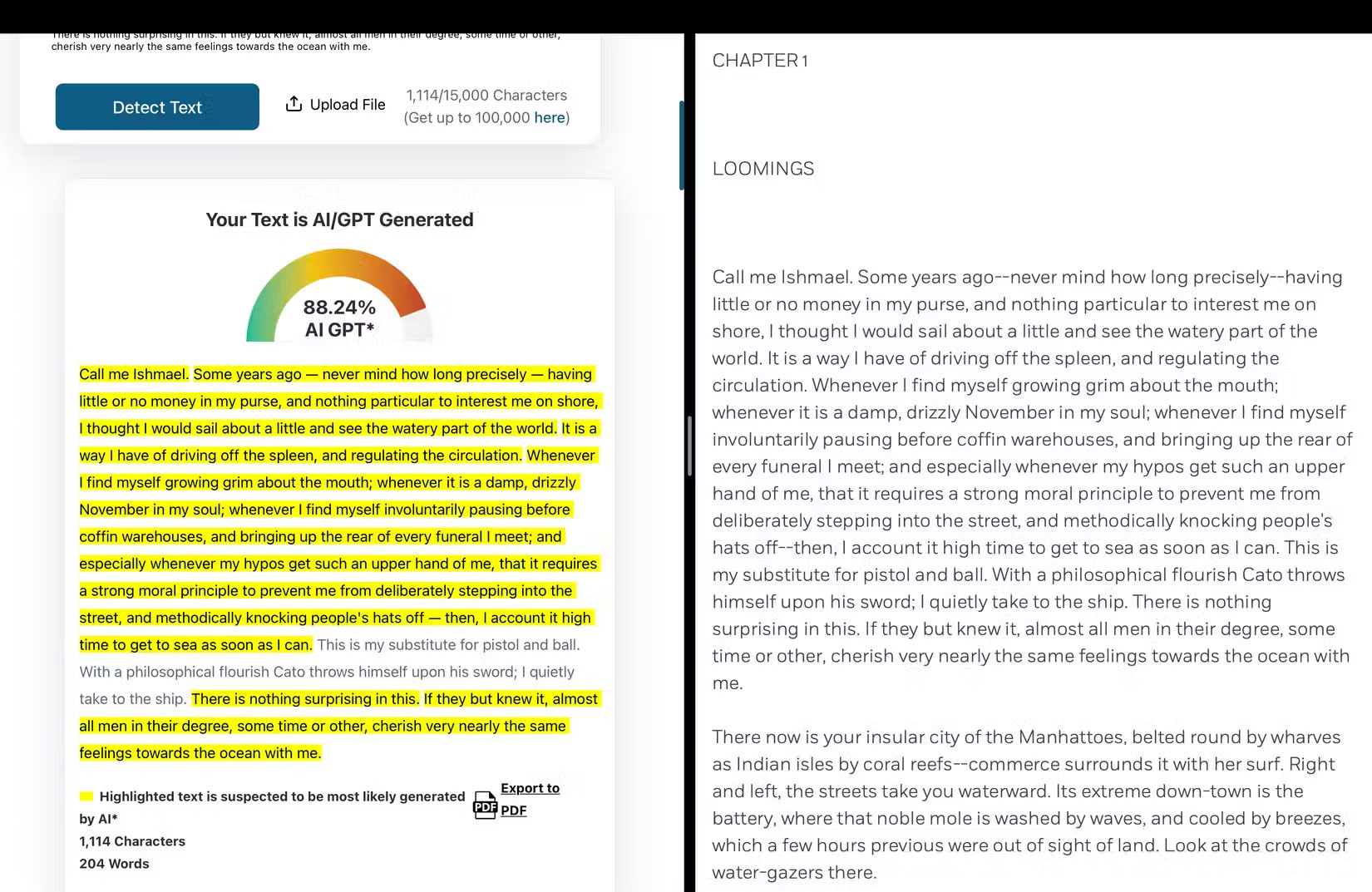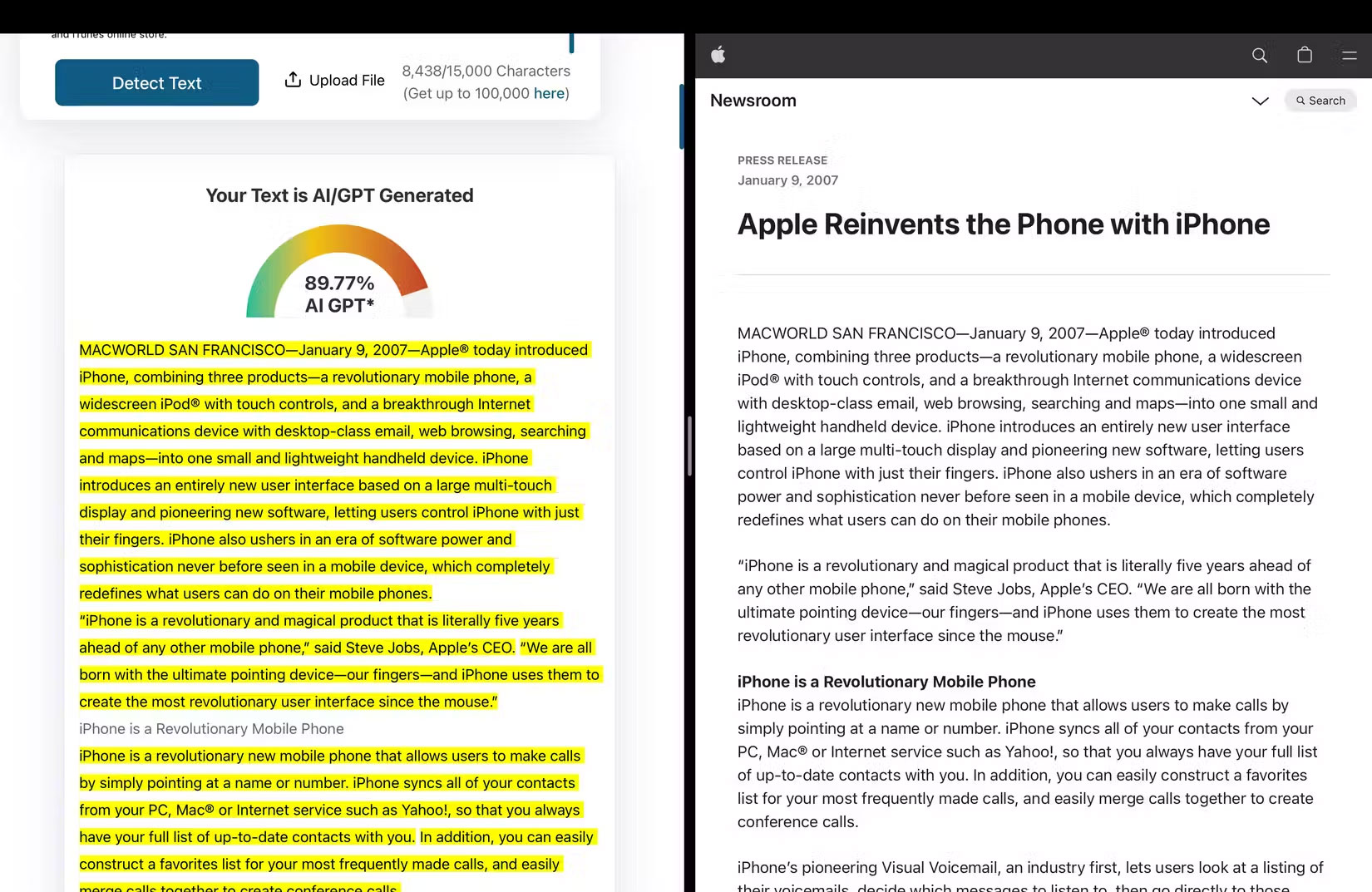5 Examples That Prove AI Content Checkers Are Useless
Whether you're a professional writer or a student who writes essays regularly, you're probably tired of running your work through AI content checking tools and then getting 100% AI-generated article results.
1. The paragraph just asked AI to write
If the AI content checker is 100% accurate, then the content generated by ChatGPT should be flagged as 100% AI generated, right?
In testing, ChatGPT's content was found to be 70% to 100% AI-generated. However, after a few tries, the text generated by ChatGPT turned out to be 100% human-written.
For example, the author asked ChatGPT to write a dialogue about the iPhone 15 Pro camera. The response was run through ZeroGPT, the most advanced and reliable ChatGPT, GPT4, AI content detection engine.
Sure enough, ZeroGPT reports that this text is 100% human-written.

So if AI-generated content can be marked as human-written, can the results be trusted in the opposite situation?
2. The United States Declaration of Independence
The United States Declaration of Independence was adopted by Congress on July 4, 1776, which means it was written nearly 250 years ago.
Unless Thomas Jefferson, the drafter, had the ability to time travel, there is simply no way that an AI could have written the Declaration of Independence. Interestingly, ZeroGPT thinks otherwise and claims that an AI created 97.75% of the text. How absurd!

3. Bible
The Hebrew Bible was completed around 100 AD, about 1,676 years before the Declaration of Independence. AI detectors, like ZeroGPT, often flag famous works of literature and historical texts as AI-generated because they influence AI models.
Regardless, the fact that entering text from the Bible into ZeroGPT triggers a 100% AI-generated warning proves that content detectors cannot be completely trusted.

4. Moby Dick
Moby-Dick, written by Herman Melville about his experiences at sea, was first published in 1851 - long before AI was invented. The author ran a famous excerpt from the first chapter through ZeroGPT and it came out to be 88.24% AI-written.

While this result isn't exactly surprising, given that AI models are influenced by classic works of literature like this, the fact that famous text was misclassified as AI-generated still highlights an important issue and shows how unreliable content detection tools can be.
5. Apple's first iPhone press release
Sure, AI models are trained on a wide variety of texts, including classic works of literature like Shakespeare and Moby Dick. While this might explain why Moby Dick might be misidentified as AI-generated when you run it through a content checker, the idea that an Apple press release would be used to train an AI model seems absurd.
Instead of running a new Apple press release through a checker, the author searched through Apple's news archive and found Apple's first press release about the iPhone. The author pasted the entire press release into ZeroGPT and it found that 89.77% of the content was AI-generated.

Aside from the headlines and a paragraph or two, the rest of the text is said to be AI-generated.
Overall, there are a lot of AI detection tools that you can try out. However, the bottom line is that AI content detection tools don't work. While this makes it even harder to detect AI-generated text, it is still possible to recognize text written entirely by AI just by reading it carefully.
You should read it
- Improve your English proficiency with these 11 Web sites
- Use the Microsoft Word Replace feature to invert the words in the column
- The secret to skin beauty in Photoshop
- How to create an animation on Android using DU GIF Maker
- 5 best laptops from HP
- 9 tips to create a 'glitter' selfie photo
- How to share speakers in LAN system?
- How to batch format photos in Windows 10
May be interested
- Collection of the most commonly used but useless objects in the world
 below is a collection of the most common but useless objects in the world by the greek art creative artist katerina kamprani. invite you to watch!
below is a collection of the most common but useless objects in the world by the greek art creative artist katerina kamprani. invite you to watch! - The price of netbooks is very useless
 pat moorhead, senior vice president of marketing for amd chip maker, claims that tiny netbooks are 'useless'.
pat moorhead, senior vice president of marketing for amd chip maker, claims that tiny netbooks are 'useless'. - Stop Installing These 8 Useless iPhone Apps!
 your iphone doesn't need half the useful apps people install. in fact, deleting them can actually make your phone run better.
your iphone doesn't need half the useful apps people install. in fact, deleting them can actually make your phone run better. - Summary of functions that handle character strings in Excel, syntax and examples
 summary of functions that process character strings in excel, syntax and examples will help you supplement important knowledge and commands with this powerful calculation tool. character string processing functions will help you extract characters anywhere in the text content.
summary of functions that process character strings in excel, syntax and examples will help you supplement important knowledge and commands with this powerful calculation tool. character string processing functions will help you extract characters anywhere in the text content. - How to use the IF function with VLOOKUP (examples and how to)
 how to use the if function in combination with vlookup (examples and how to do it). if you are looking to use the if function with vlookup with specific examples, please refer to the following article. the following article will guide you 3 common cases using the if function
how to use the if function in combination with vlookup (examples and how to do it). if you are looking to use the if function with vlookup with specific examples, please refer to the following article. the following article will guide you 3 common cases using the if function - 19 most useless inventions on earth, it is better not to have more
 the following are some of the creative items created by humans but they are not necessary because they have no effect at all.
the following are some of the creative items created by humans but they are not necessary because they have no effect at all. - Basic examples of HTML
 in the previous html lesson, you know which tools to use to write html code, how to save and open html files. this article will give some basic examples of html text.
in the previous html lesson, you know which tools to use to write html code, how to save and open html files. this article will give some basic examples of html text. - How to Prove Ownership of Car
 motor vehicles, generally, are considered 'titled property' in the us. this means if the vehicle's title is in your name, you are the legal owner of the vehicle. in the absence of a title, you may be able to use other documents to prove...
motor vehicles, generally, are considered 'titled property' in the us. this means if the vehicle's title is in your name, you are the legal owner of the vehicle. in the absence of a title, you may be able to use other documents to prove... - Function Address - The function returns the address of a cell in Excel (usage, examples, examples)
 the following article dexterity software will introduce readers to the address function one of the most popular reference and lookup functions in excel.
the following article dexterity software will introduce readers to the address function one of the most popular reference and lookup functions in excel. - Top 10 'most worthless' qualifications in universities (and the reason behind them)
 let's see the top 10 most valuable qualifications in university and the reason behind them!
let's see the top 10 most valuable qualifications in university and the reason behind them!










 Which animal gives birth to the most children?
Which animal gives birth to the most children? Find out why your hard drive is showing the wrong capacity
Find out why your hard drive is showing the wrong capacity Suggestions on how to fix computer error please wait
Suggestions on how to fix computer error please wait What to do when Startup Repair takes too long?
What to do when Startup Repair takes too long? Should I buy Intel Core Ultra 5, 7 or 9 laptop CPU?
Should I buy Intel Core Ultra 5, 7 or 9 laptop CPU? How to get early access to game demos and releases
How to get early access to game demos and releases